Over many months, StorageReview has been testing and analyzing two Dell EMC VCE VxRack Node all flash PF100 clusters – which is the predecessor to the recently released Dell EMC ScaleIO Ready Node. One set of tests centered on the system configured in HCI, and the other in two-layer. If this sounds a bit strange, it is, as no storage is more flexible than ScaleIO. Hyperconverged is typically that; compute and storage combined into the same easy-to-manage platform. And just as it sounds two-layer is the separation of storage and compute as is typical in a traditional architecture. Dell EMC ScaleIO eschews the strict definition of both notions, allowing an enterprise to configure either way, or both ways. The Dell EMC ScaleIO solution meets the demands of organizations that want the best of each world, whenever they like.
It's not just an architecture choice that defines the flexibility of ScaleIO though. ScaleIO can also run bare metal OS, integrated with all major hypervisors including VMware (as in our review environment), Hyper-V and KVM, or OpenStack. Our testing was done on all flash nodes, but ScaleIO supports a wide variety of drive configurations including all-disk, all-flash and hybrid combinations. ScaleIO may also be purchased as an engineered solution from VCE as is the case here, or organizations can build their own. EMC also offers a full version of the software to use free of charge and registration, for non-production environments.
We break down more of the feature set in the VxRack Node Overview, for those who want to dig more into the background. Ultimately though, our emphasis on testing was largely around performance.
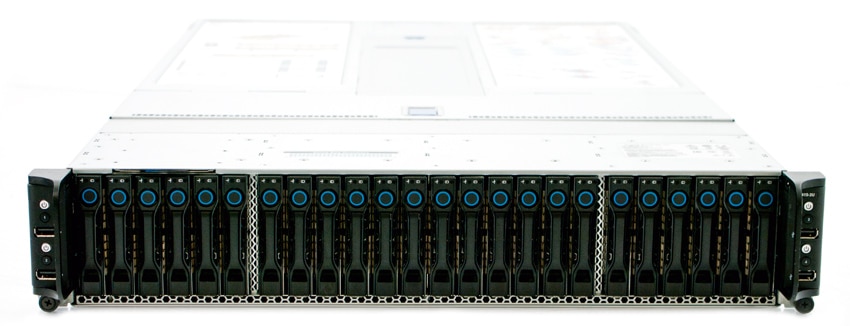
VCE VxRack Node (Performance Compute All Flash PF100) Specifications
- Chassis – # of Node: 2U-4 node
- Processors Per Node: Dual Intel E5-2680 V3, 12c, 2.5GHz
- Chipset: Intel 610
- DDR4 Memory Per Node: 512GB (16x 32GB)
- Embedded NIC Per Node: Dual 1-Gbps Ethernet ports + 1 10/100 management port
- RAID Controller Per Node: 1x LSI 3008
- SSDs Per Node: 4.8TB (6x 2.5-inch 800GB eMLC)
- SATADOM Per Node: 32GBSLC
- 10GbE Port Per Node: 4x 10Gbps ports SFP+
- Power Supply: Dual 1600W platinum PSU AC
- Router: Cisco Nexus C3164Q-40GE
As we wrap up our coverage, we've included highlights from each segment of the review:
EMC VxRack Node Powered By ScaleIO: Scaled Sysbench OLTP Performance Review (2-layer)
EMC VxRack Node Powered By ScaleIO: Scaled Sysbench OLTP Performance Review (HCI)
In our Scaled Sysbench performance test in both 2-layer and HCI configurations, we note that even at 99.2% storage utilization, ScaleIO showed no signs of slowing down. In fact the performance we measured in Sysbench at the time was the highest ever.
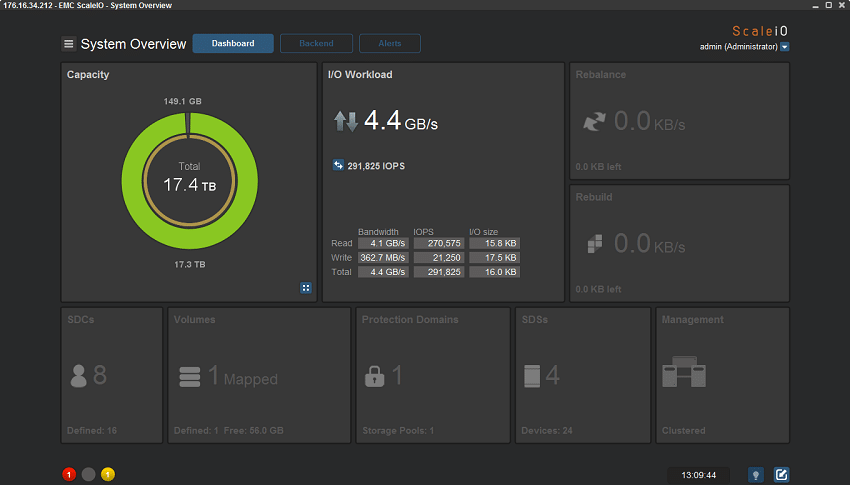
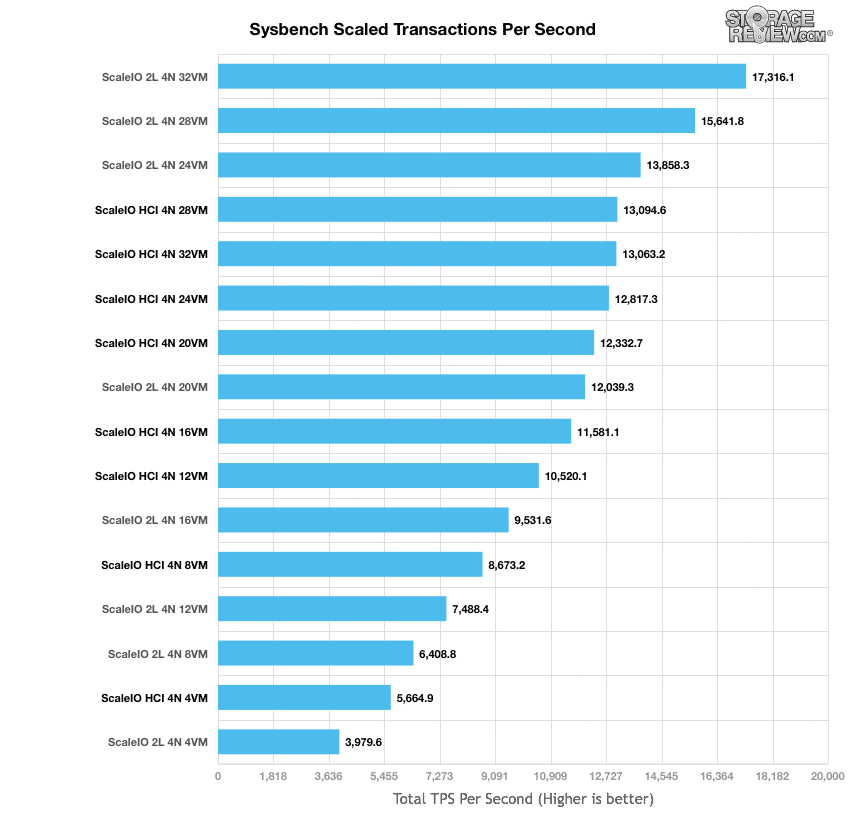
EMC VxRack Node Powered By ScaleIO: SQL Server Performance Review (2-layer)
EMC VxRack Node Powered By ScaleIO: SQL Server Performance Review (HCI)
Continuing on in our database tests, we measured SQL Server performance. Here we found very balanced performance (exceeded only by locally attached flash devices), which far surpasses other shared storage offerings. Another interesting aspect we uncovered was how well ScaleIO performed in an HCI configuration, exceeding the performance we measured in our 2-layer results.
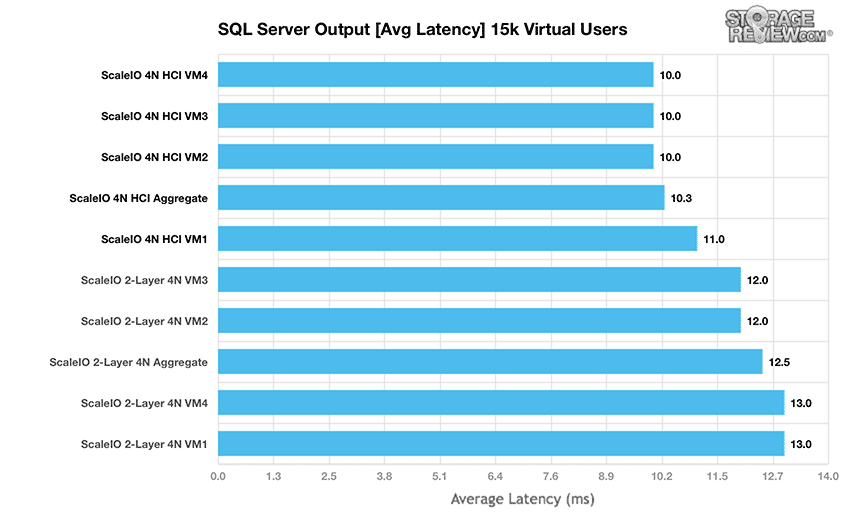
EMC VxRack Node Powered By ScaleIO: Synthetic Performance Review (2-layer)
EMC VxRack Node Powered By ScaleIO Review: Synthetic Performance Review (HCI)
Our next series of tests put both the 2-layer and HCI configurations up against one another, so that we could observe how each would handle our HCIbench synthetic tests. Here we noted that 2-layer does offer an edge at higher loads, although both are able to offer incredible bandwidth— supporting even the most demanding workloads.
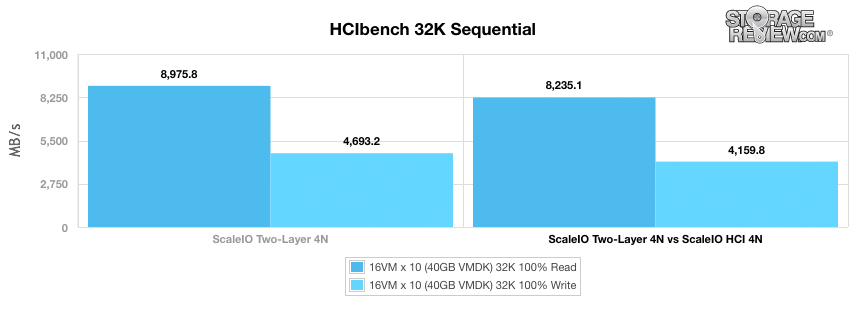
EMC VxRack Node powered by ScaleIO: VMmark Performance Review (2-layer)
EMC VxRack Node Powered By ScaleIO: VMmark Performance Review (HCI)
Finally, as we looked at how well ScaleIO performed in the VMware VMmark virtualization test, we saw exemplary performance in both configurations. The most impressive feat though was how well ScaleIO in HCI did, demonstrating how little impact the storage overhead has on the platform.
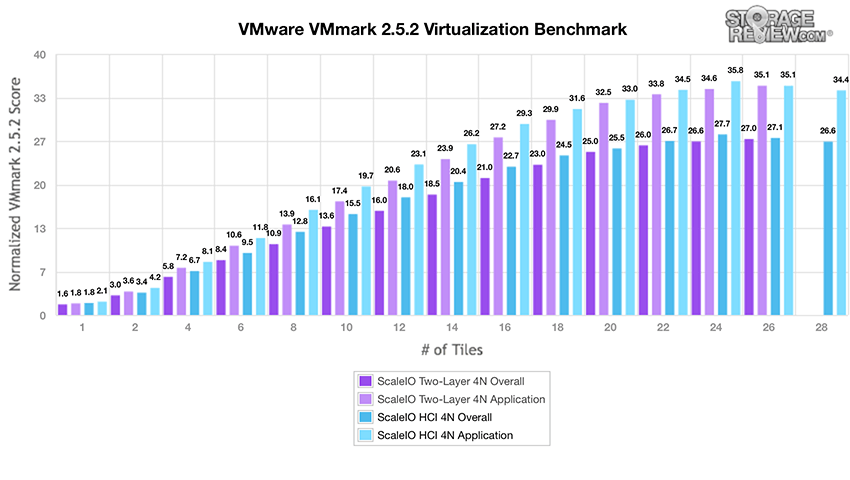
Conclusion
Doing a summary wrap-up review is somewhat unusual for us, as we generally try to condense a review into a couple of pieces or less. However, Dell EMC's ScaleIO made us rethink that process, ultimately because a condensed review clearly wouldn't have done the system justice. The deployment is simply so flexible that testing that would normally take a few weeks, took much longer. As such, we decided to publish content as we completed it in order to get the information and results out as soon as possible. Our ScaleIO story is not over though. With the Dell acquisition, we're already in talks to explore ScaleIO further by testing the new Dell EMC ScaleIO Ready Nodes, with an emphasis on resiliency (which we ran out of time for this round) and new application tests.
As you can see from the summary results above, we were blown away with the Dell EMC ScaleIO solution throughout the review process. Dell EMC ScaleIO is far and away the most impressive storage solution that we've not only seen this year, but probably ever. The performance, flexibility and reliability of ScaleIO is nothing short of astounding. Over the course of several months, it also made us rethink the way we acknowledge such superior performance. At the conclusion of this phase of the review, we decided to launch a StorageReview Editor's Choice award that will be judiciously granted for only the best-of-the best products we see.
For its astounding performance, flexibility and reliability, the Dell EMC ScaleIO VxRack solution is the first recipient of the StorageReview Editor's Choice award. We now look forward to the efforts of the combined company, anticipating the day when refreshed gear shows up in the lab for more extensive work.





 Amazon
Amazon